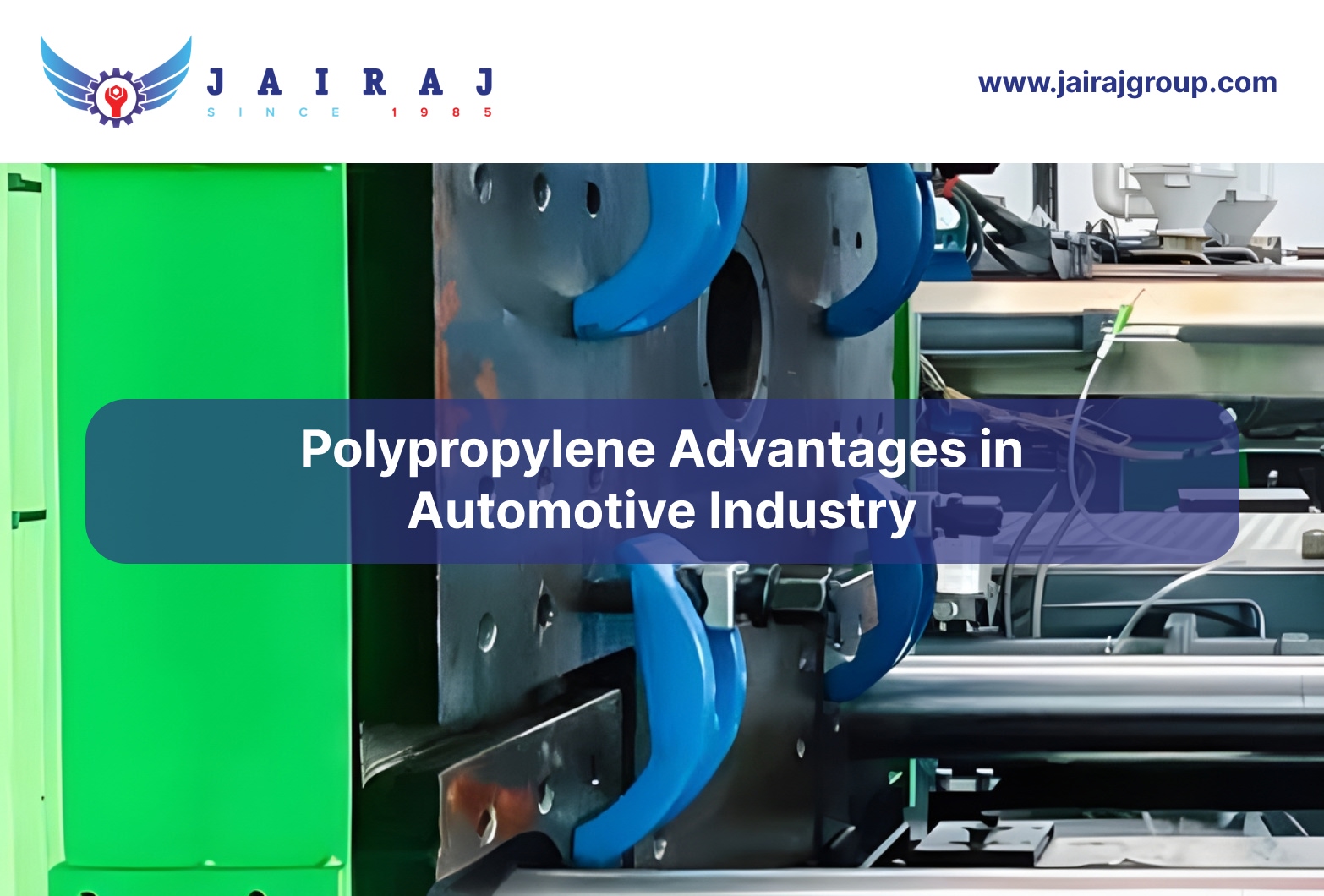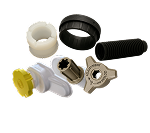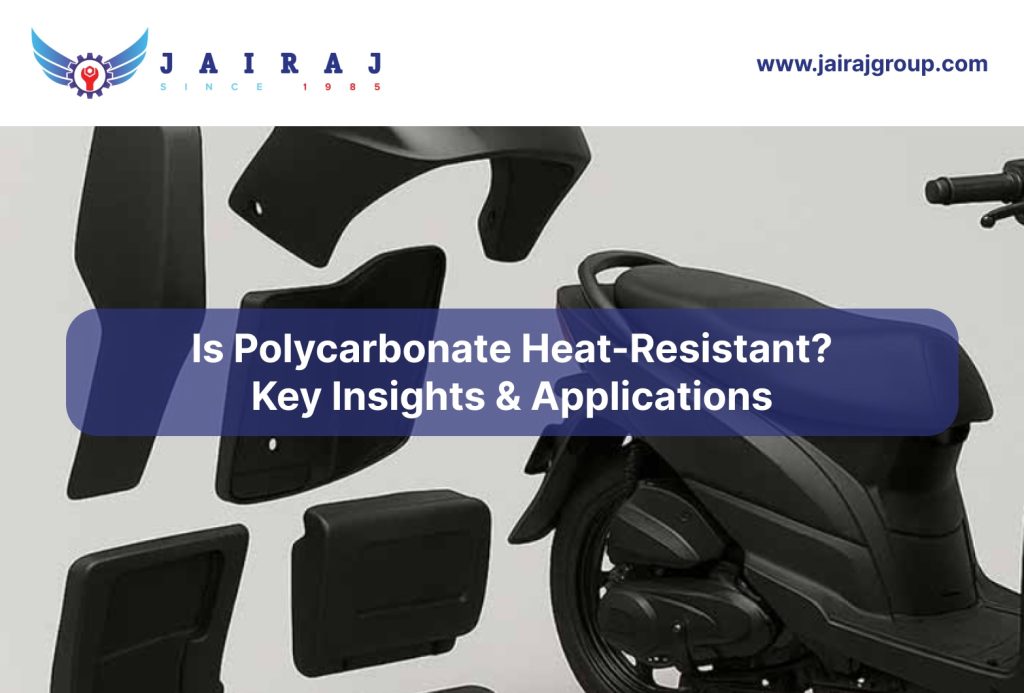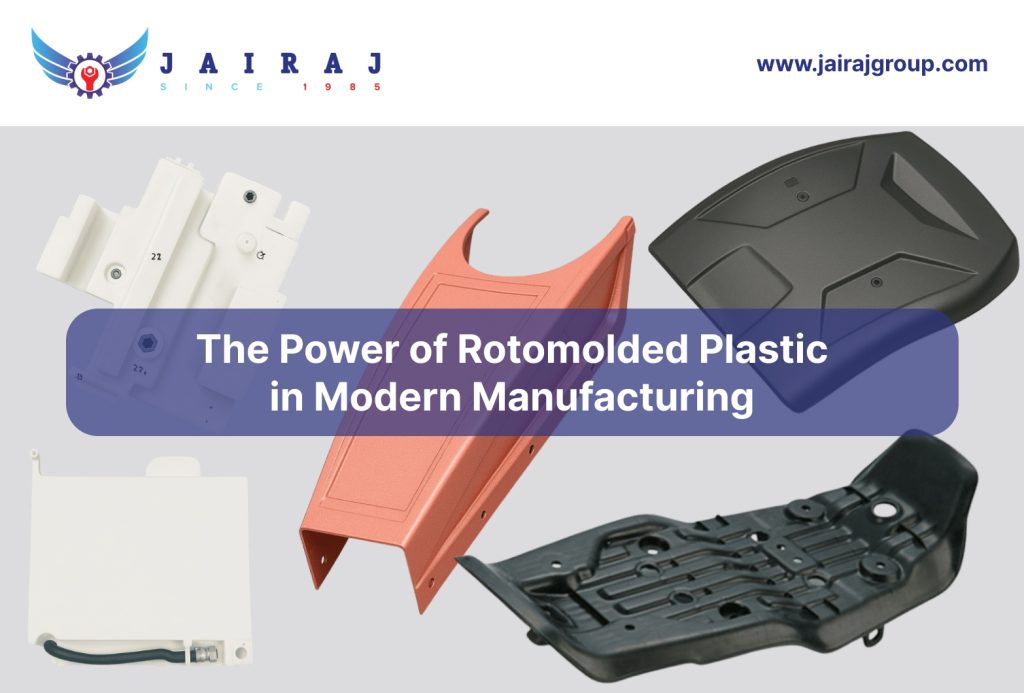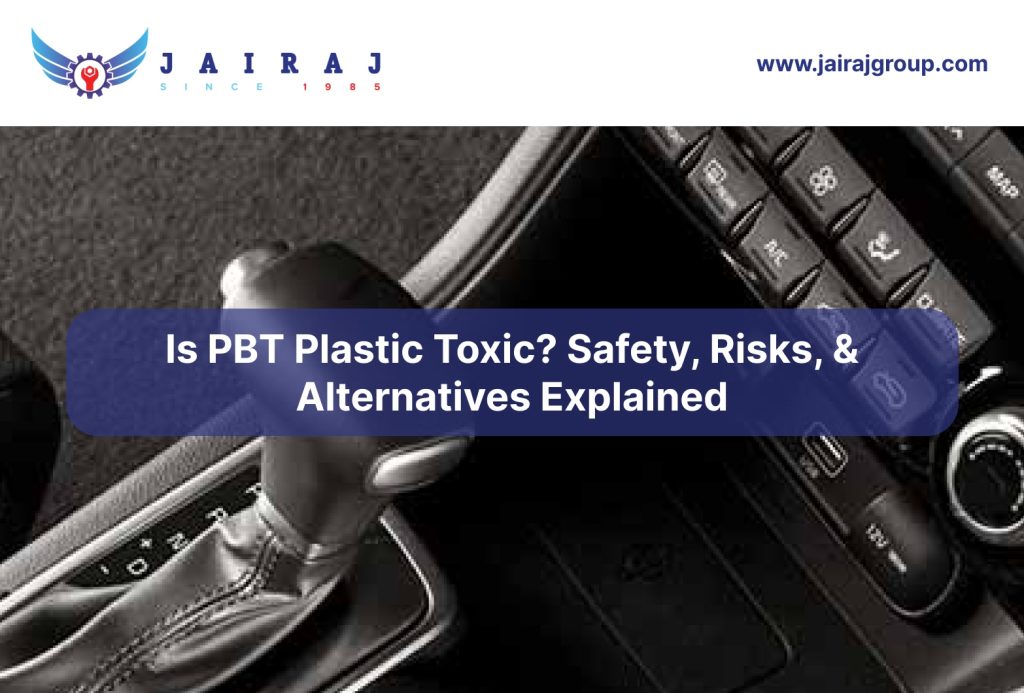Polypropylene (PP) has become one of the most essential materials in the automotive industry, valued for its versatility, durability, and performance under demanding conditions. With the global PP compound for the automotive market projected to reach USD 29.94 billion by 2033, its growing adoption reflects the industry’s shift toward lightweight, high-performance materials.
As procurement managers, design engineers, and plant managers prioritize efficiency, cost, and sustainability, polypropylene automotive components stand out as a critical choice. Even in internal combustion engine (ICE) or electric vehicles (EVs), PP offers weight reduction, improved fuel efficiency, and consistent performance without compromising strength or design flexibility.
In this blog, we will look into the properties, benefits, applications, and future trends of polypropylene in the automotive manufacturing industry.
Key Takeaways
- Polypropylene reduces vehicle weight, improving fuel efficiency and range, particularly for electric vehicles.
- Its durability and impact resistance make it essential for safety-critical automotive parts like bumpers and fuel tanks.
- Polypropylene’s resistance to UV degradation ensures long-lasting exterior components.
- Advanced molding technologies like injection and blow molding enhance the design flexibility of polypropylene automotive parts.
- Being recyclable, polypropylene contributes to sustainability efforts in automotive manufacturing, aligning with eco-friendly goals.
Properties of Polypropylene in Automotive Components
Polypropylene is increasingly used in automotive manufacturing due to its unique blend of characteristics. Below are five specific properties that make polypropylene indispensable in the automotive sector:
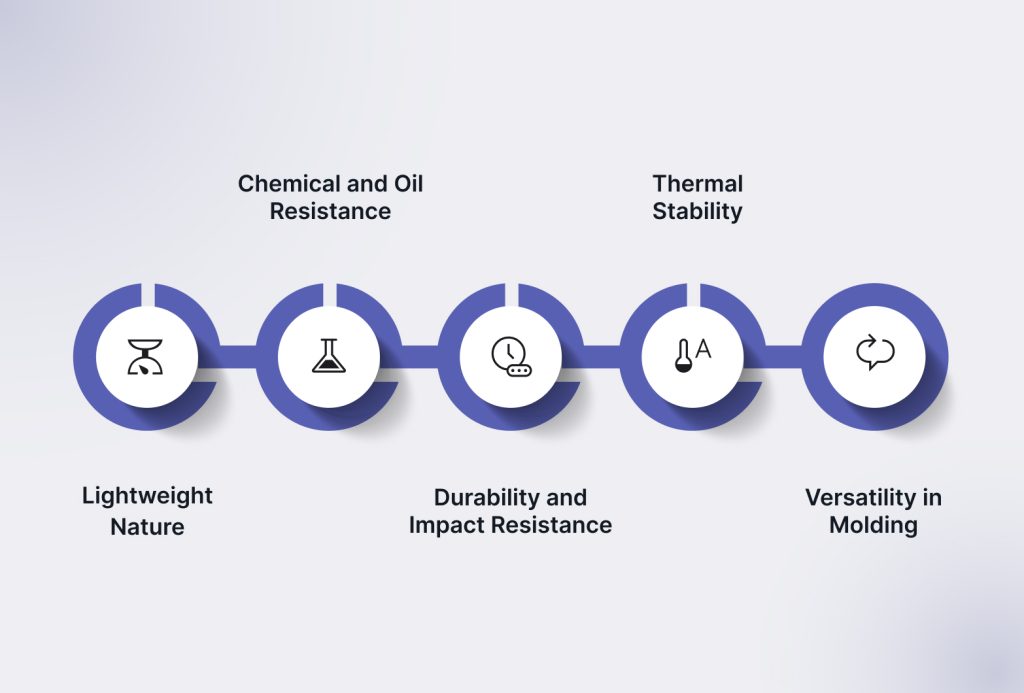
Lightweight Nature
Polypropylene is a low-density thermoplastic, which makes it lighter than other plastics like PVC and certain metals. This property is crucial for the automotive industry, where reducing vehicle weight is essential for improving fuel efficiency and reducing CO₂ emissions.
In electric vehicles (EVs), where maximizing range is critical, lightweight materials such as polypropylene automotive components directly enhance battery efficiency and overall performance.
Chemical and Oil Resistance
Polypropylene exhibits excellent resistance to oils, fuels, acids, and alkaline solutions. In automotive applications, this resistance makes it ideal for parts exposed to harsh chemical environments, such as fuel tanks, oil filters, and under-the-hood components. For example, polypropylene is used in automotive fuel system components that require durability and resistance to fuel and oil degradation, ensuring longer service life and enhanced safety.
Durability and Impact Resistance
Polypropylene is highly resistant to impact and wear, making it ideal for automotive components subjected to high levels of stress. For instance, PP is commonly used in bumpers and fenders, where its ability to absorb impact without cracking or breaking is critical for maintaining vehicle integrity during collisions.
Thermal Stability
Polypropylene has good thermal stability, which makes it suitable for automotive applications exposed to high temperatures. For example, PP is used in engine covers, air intake manifolds, and other components that need to withstand significant temperature variations. This stability ensures the material can maintain its structural integrity even in the intense heat found under the hood of a vehicle.
Versatility in Molding
Polypropylene’s moldability allows for a wide range of design possibilities, from complex geometries to intricate detailing. It can be processed using injection molding, blow molding, and rotational molding techniques, providing manufacturers with design flexibility. This property makes PP especially valuable for both functional parts (such as battery housings) and aesthetic components (like dashboards) in the automotive sector.
Jairaj Group uses fiber-reinforced polypropylene (PPCP) to manufacture fuel line connectors and shock absorber covers that combine high strength with reduced vehicle weight. Our Plastic Injection Molding technology ensures dimensional stability and chemical resistance under extreme conditions. Using Nylon 6/66 GF compounds and computer-aided mold design, we deliver components that maintain structural integrity and crash safety while improving overall fuel efficiency.
Its performance advantages translate directly into tangible benefits across modern vehicle designs.
7 Benefits of Polypropylene in Automotive Applications
The exceptional properties of polypropylene result in numerous benefits for automotive applications. Here are seven key advantages:
Weight Reduction for Enhanced Fuel Efficiency
Polypropylene automotive parts, including interior trim, door panels, and battery casings, help reduce the overall weight of the vehicle, thereby improving fuel economy. For electric vehicles, this weight reduction also translates to a longer driving range per charge, which is particularly important in the growing EV market.
Cost-Effective Manufacturing
Automotive manufacturers, particularly those focused on mass production, benefit from the low cost of polypropylene compared to metals like aluminum and steel. In mass-market vehicles, where cost reduction is a priority, polypropylene components help keep production costs down while maintaining performance.
Durability and Low Maintenance
Polypropylene’s resistance to wear, impact, and UV radiation makes it an excellent choice for parts exposed to the elements, such as bumpers and exterior trim. For example, polypropylene is commonly used in front-end bumpers, where it is expected to absorb impact energy during collisions. The material’s durability reduces the need for frequent replacements, making it a cost-effective solution for manufacturers and consumers.
Improved Performance in EVs
In electric vehicles, reducing weight and improving energy efficiency are paramount. Polypropylene is increasingly used in EVs for parts like battery enclosures, interior components, and exterior panels. Its lightweight nature and ability to withstand high temperatures contribute to better overall vehicle performance. For instance, polypropylene is used in Tesla’s battery casings to provide both thermal stability and impact resistance while reducing weight, which directly enhances the car’s energy efficiency.
Enhanced Design Flexibility
Polypropylene is used in intricate automotive interior parts, such as dashboards and door panels, which require both aesthetic appeal and functional durability. The ability to mold PP into complex shapes allows manufacturers to produce parts that meet specific design requirements without compromising performance.
Resistance to UV and Environmental Exposure
Automotive components, particularly those on the exterior of vehicles, are constantly exposed to UV radiation, heat, and moisture. Polypropylene’s inherent resistance to UV degradation makes it ideal for producing long-lasting exterior components, such as trim and wheel covers. The UV-resistant properties ensure that parts retain their structural integrity and appearance over time, even when exposed to harsh sunlight and varying weather conditions.
Environmental Sustainability
In an industry increasingly focused on sustainability, the use of recyclable materials like polypropylene helps manufacturers comply with regulations and meet the growing demand for eco-friendly vehicles. This is especially significant as the industry moves toward a circular economy model, where the reuse of materials reduces the environmental impact of production.
Also Read: A Complete Guide to Insert Molding and Its Uses
Its versatility enables multiple applications across automotive systems.
5 Uses and Applications of Polypropylene Components in Automotive Manufacturing
Polypropylene is used in a wide variety of automotive components, each serving critical functional and aesthetic purposes. Here are five notable examples of polypropylene applications:
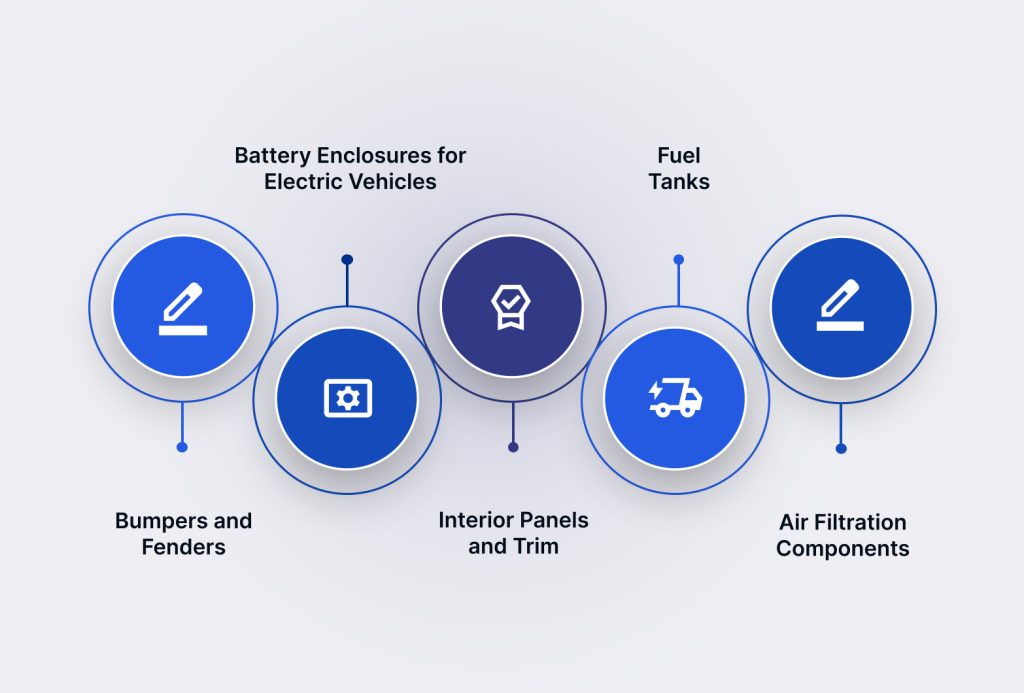
Bumpers and Fenders
Polypropylene is widely used in the manufacture of bumpers and fenders due to its exceptional impact resistance and ability to absorb energy. For example, polypropylene-based bumpers can deform upon impact and then return to their original shape, ensuring the vehicle’s integrity remains intact during low-speed collisions.
Battery Enclosures for Electric Vehicles
As electric vehicles (EVs) become more prevalent, polypropylene’s use in battery enclosures has expanded. Its resistance to heat and chemicals makes it ideal for housing the sensitive components in EV batteries. The lightweight nature of PP reduces the overall weight of the vehicle, improving energy efficiency while maintaining the safety and structural integrity of the battery pack.
Interior Panels and Trim
Polypropylene’s moldability allows it to be used in the production of interior panels, dashboards, and door trim. The material can be molded into complex shapes, providing both aesthetic appeal and durability. It is often used in the production of interior parts for mass-market vehicles, where both cost efficiency and design flexibility are essential.
Fuel Tanks
Polypropylene is commonly used in automotive fuel tanks, where it provides resistance to various fuels and chemicals. In particular, PP’s resistance to fuel permeation and its ability to withstand high temperatures make it an ideal choice for fuel tank manufacturing. This ensures that fuel tanks remain intact under extreme driving conditions, helping to prevent fuel leaks and enhance vehicle safety.
Air Filtration Components
Polypropylene is also used in automotive air filtration systems, such as cabin air filters and engine air filters. The material’s resistance to moisture, heat, and chemicals makes it ideal for these applications. Additionally, polypropylene’s ease of molding allows manufacturers to produce high-performance filters that contribute to better engine efficiency and cabin air quality.
Also Read: Overmolding Guide: Process, Design, and Importance
The material’s growing relevance underscores its future potential in advanced automotive manufacturing.
The Future of Polypropylene Components in Automotive Manufacturing
Innovations in vehicle design and manufacturing will be fueled in large part by polypropylene as the automotive industry develops. Here are five trends shaping the future of polypropylene automotive components:
Increased Use in Electric Vehicles (EVs)
The rise of electric vehicles is expected to significantly boost the demand for polypropylene automotive components. With a focus on reducing weight and enhancing energy efficiency, PP’s lightweight properties and versatility make it an ideal material for a wide range of EV components, including battery enclosures, interior trim, and exterior panels.
Advancements in Composite Materials
As polypropylene is combined with other materials like glass fibers and carbon fibers, it is being used to produce high-strength, lightweight composites. These composites offer enhanced mechanical properties, making them suitable for critical automotive applications such as structural components, body panels, and safety features.
3D Printing of Polypropylene Components
With the increasing use of 3D printing in automotive manufacturing, polypropylene is becoming a material of choice for additive manufacturing. Its ability to be molded into complex shapes allows for rapid prototyping and customized production of automotive parts, from dashboard components to bespoke interior trim.
Sustainability and Recycling Innovations
The automotive industry’s push towards sustainability will continue to drive the development of more efficient recycling technologies for polypropylene. Innovations in chemical recycling methods will allow automotive manufacturers to reuse polypropylene components, contributing to a more sustainable, circular economy.
Smart Polypropylene Components
As automotive systems become more interconnected, polypropylene is being integrated with smart technologies, such as sensors and conductive materials, to create intelligent automotive components. These smart polypropylene parts can monitor vehicle performance, adjust to changing conditions, and communicate with other vehicle systems, paving the way for more advanced and efficient vehicles.
Also Read: Rib Molding Design Guide: Reducing Costs and Strengthening Supplier Outcomes
To fully maximize its potential, collaboration with industry leaders specializing in polypropylene automotive engineering is key.
Collaborate with Industry Experts in Polypropylene Automotive Engineering
Polypropylene (PP) provides lightweight solutions for components like bumpers, fuel tanks, and interior parts. Its ability to reduce weight while maintaining high strength makes it essential for enhancing fuel efficiency and performance.
At Jairaj Group, we have over 35 years of expertise in polymer manufacturing and advanced production technologies like injection molding, blow molding, and rotational molding. We specialize in manufacturing custom polypropylene components that meet stringent industry standards for automotive applications.
Here’s how Jairaj Group is shaping the future of automotive components with polypropylene and advanced manufacturing technologies:
- Plastic Bellows & Struts: Jairaj Group’s polypropylene bellows and struts are critical in automotive applications for vibration damping and protection of sensitive parts. We ensure durability even under high-stress conditions in heavy-duty vehicles and railways, providing long-lasting performance.
- Brake & Accelerator Pedals: Our polypropylene brake and accelerator pedals offer robust performance in automotive applications. Designed with precision, they ensure safety and reliability for two-wheelers, four-wheelers, and earthmover vehicles, all while reducing weight and improving fuel efficiency.
- Shockers & Suspension Components: With our advanced polypropylene shockers and suspension components, we provide exceptional impact resistance and flexibility. These components are crucial in ensuring vehicle stability across automotive, two-wheeler, and heavy-duty vehicle sectors, contributing to smoother rides and improved safety.
- Roto Moulding Components: For industries like automotive, defense, and aerospace, Jairaj Group offers high-performance roto moulding components, manufactured from durable polypropylene. These components are engineered for reliability and versatility, meeting stringent safety standards and enhancing vehicle performance.
- Interior & Exterior Accessories: Our polypropylene-based interior and exterior accessories ensure both aesthetic appeal and high functionality. From trim pieces to panels, Jairaj Group delivers automotive parts that resist UV degradation, chemical exposure, and physical wear, ensuring long-term durability and high-end finishes.
- Precision Components from Advanced Polymers: Jairaj Group’s precision polypropylene components cater to industries requiring high tolerance and exacting specifications. We provide custom-engineered solutions for the automotive, aerospace, and defense sectors, ensuring top-tier quality and performance for even the most demanding applications.
With facilities in Faridabad, Rudrapur, Aurangabad, Manesar, and Sanand, we utilize cutting-edge technology and advanced molding processes to produce precision-engineered parts that improve vehicle performance and reduce overall manufacturing costs.
Conclusion
Polypropylene’s widespread use across a variety of automotive applications, ranging from bumpers and fuel tanks to interior trim and battery enclosures, demonstrates its indispensable role in modern automotive manufacturing. With its inherent recyclability, thermal stability, and adaptability to innovative manufacturing methods, polypropylene automotive components will continue to shape the future of the industry.
At Jairaj Group, we utilize Polypropylene (PPCP) and Polyethylene (PE) in the production of Dust Covers, Guide Springs, and Shock Absorber Covers, components that demand durability and precision under dynamic load conditions. Using Extrusion Moulding and Plastic Assembly Lines, we achieve dimensional consistency and high tensile strength. Our plastic welding and machining techniques enhance structural rigidity while minimizing vehicle weight, delivering superior performance and fuel efficiency across automotive applications.
Contact Jairaj Group to improve your automotive manufacturing with our high-quality polypropylene components.
FAQs
1. What automotive components benefit most from polypropylene?
Polypropylene is ideal for bumpers, fuel tanks, dashboards, and battery enclosures, offering lightweightness, durability, and chemical resistance for both internal combustion and electric vehicles.
2. How does polypropylene enhance vehicle fuel efficiency?
By reducing vehicle weight, polypropylene helps improve fuel efficiency, especially in electric vehicles, where every kilogram saved contributes to longer range and better performance.
3. Is polypropylene durable enough for automotive use?
Yes, polypropylene offers excellent impact resistance and longevity, making it perfect for automotive components exposed to wear, UV radiation, and harsh environmental conditions.
4. How does polypropylene contribute to automotive safety?
Polypropylene’s ability to absorb impact energy makes it ideal for bumpers and crash-resistant parts, enhancing vehicle safety during collisions while maintaining structural integrity.
5. Can polypropylene components be recycled in the automotive industry?
Yes, polypropylene is fully recyclable, making it an environmentally friendly material choice for automotive manufacturing, supporting sustainability and circular economy initiatives.
6. What are the advantages of using fiber-reinforced polypropylene in automotive parts?
Fiber-reinforced polypropylene offers enhanced mechanical strength, impact resistance, and thermal stability, making it ideal for high-stress automotive components like structural parts and suspension systems.

